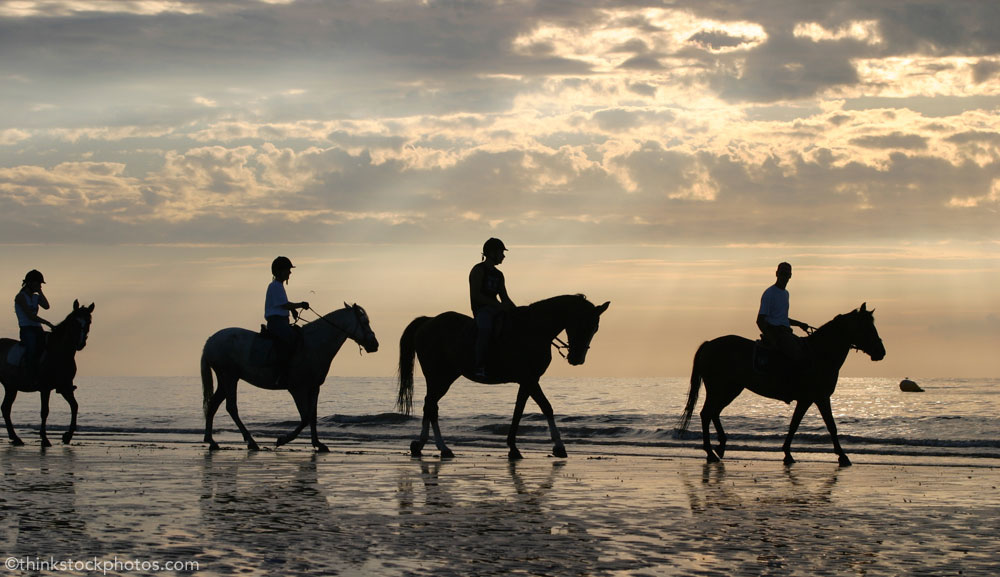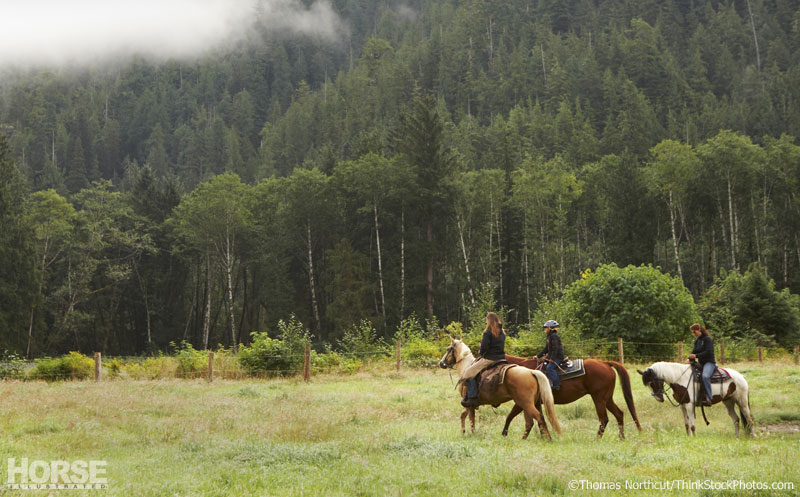You can travel anywhere in the civilized or not so civilized world for a riding holiday these days. But there’s no need to lug along a giant tack trunk of gear to enjoy the ride. Our equestrian vacation experts share their advice on what essentials to pack so that you have everything you need for the trip of a lifetime, on horseback.

On trips where you’ll be logging a lot of saddle time, whether riding western or English, comfort is key. “Take clothes that are comfortable, nothing that rubs, nothing new. Boots should be broken in; breeches, schooling tights and riding jeans should fit well. A trail ride is not the time to break things in that you have not worn before,” says Karen Lancaster, president of Cross Country International, which has specialized in equestrian travel around the world for 15 years. While most tours don’t allow you to bring your own saddle (not very practical to carry, as well as problematic for having to fit the horse), Karen advises that bringing a sheepskin or gel seat saver can add to your comfort. “Padded underwear is also a help,” she says.
Our experts agree that a waist pack is most useful for carrying items on horseback such as camera and film, Kleenex, lip balm, sunscreen, et cetera. “A backpack can be dangerous and saddlebags can bounce at trot and canter,” explains Nancie Vion-Loisel, a ride consultant with Equitours. Bayard Fox prefers bags that fit on the front of the saddle. “Hard items like cameras attached behind can upset a horse, especially if they start to come loose,” he says. If tying a jacket behind your saddle, make sure it is securely fastened.
For an intensive English training vacation, such as dressage or jumping, you’ll want your wardrobe to be conducive to the best possible learning experience. Neat and workmanlike riding clothes will allow your instructor to see your form. Breeches, field or dress boots, helmet and gloves are the attire Karen recommends. She also brings a boot cleaning kit. For jumping, you might want to add a protective vest.
Coping with Weather Extremes
“When riding in cold climates like Iceland or even Northern Scotland I like corduroy stretch tights, riding mittens and a riding fleece head band,” Karen says. Her advice is to layer clothing, as needed: long underwear, turtleneck, sweaters or fleece, then jacket. “Layers are the way to go,” Bayard agrees.
A jacket that travels and layers well is a pivotal item for the well-prepared traveler. But don’t fret about packing a bulky parka. The latest generation of outerwear for riders offers many options. Look for a lightweight waterproof breathable shell as your main defense against the elements, and let layers provide the warmth.
“Outerwear that is both wind and water resistant is great,” Nancie says. Australian-style oilskin coats are a favorite with her because they can be used as an overcoat on the street when traveling, as well as for raingear when riding.
Bayard cautions against crinkly, flapping raincoats, although he recalls the popularity of the yellow saddle slickers worn by cowboys in the Marlboro ads. “I remember one time when I got bucked off big time because a raincoat tied on behind the saddle had spooked a horse on the first canter,” Bayard relates. The matter of the crackling rain gear is important, he says, noting that it can be problematic in the wind, or when getting on or off the horse.
A jacket that is totally waterproof, fits over the saddle, offers freedom of movement and handy pockets is what Karen Lancaster prefers. Versatility is also important in a jacket. The Riding Sport International 5-in-1 Jacket from Dover Saddlery is one that she likes. “On wet mild days the outer jacket can be worn, and a vest can be added when it is colder,” she explains. Karen’s other picks are waterproof riding boots and fleece waterproof gloves—take at least two pairs if they might get wet, she suggests. “I also bring those packets that heat up when you squeeze them,” she says.

If you will be riding through water or in a rainy climate, you might wind up with a pile of heavy, soggy clothes if you don’t plan ahead. Quick drying fabrics are a help, such as nylon, polyester, fleece and other modern technical fabrics.
To beat the heat less is usually more, but Ellen Vanuga, who is responsible for organizing and booking Equitours’ riding safaris in Africa, has some special advice for riders in those extreme conditions. “The African sun is fierce, and it’s easy to burn quickly before you even realize it’s happening. I’ve tried just about every type of shirt, and by far the best are—believe it or not—loose fitting safari shirts with long sleeves and tabs to hold rolled up sleeves into place, a vented yoke, a collar to protect the back of your neck, a pocket or two for lip balm and long enough shirttails to tuck into breeches. The material is tough and holds up well when riding through whistling thorn and acacia.
“Something as simple as having the right kind of shirt for safari can make a big difference in your overall comfort level,” Ellen says. “Better to be focusing on that herd of giraffe rather than worrying about ripping your shirt to shreds on the thorns.” Additionally, she explains, “Neutral, or ‘bush-colored’ clothing is important on the safaris where wildlife viewing is a big part of the daily adventure. Bright colors, particularly red and white, are highly visible for a long distance across the savannah, and are a universally understood alarm signal to the wildlife that riders are hoping to encounter. The idea is to blend into the landscape by wearing neutral tans, khakis and greens.”
Boots & Helmets To Go
Tall boots and helmets are two key items of riding apparel that can be tricky to travel with. Luggage designed especially for these two items can be a worthwhile investment. These are widely available from equestrian manufacturers including Ariat, Devon-Aire and Kensington. “One of the best things I ever bought was a custom bag from Dover—it fits my boots, helmet, gloves, toiletries and a day’s clothes,” says Karen Lancaster of Cross Country International. “People ask me at airports and on rides where I got it all the time. You can take it on board, so if all your other luggage is delayed you can ride and brush your teeth!”
Alternatively, Equitours’ Nancie Vion-Loisel says, “Paddock boots and half chaps work equally well for western and English riding and don’t weigh as much as western boots and full chaps in luggage.” HI’s editorial staff suggests wearing your paddock boots on the plane so that you don’t have to pack them.
“Half chaps and paddock boots allow you to hop off your mount and be comfortable,” Karen explains.
Equitours’ Bayard Fox adds, “It is important that the boots be well broken in and comfortable for a long day in the saddle. Many rides have places where walking is necessary at times, and in these cases it is important to have boots that are comfortable to walk in.”
Helmets are also tops on Bayard’s list. “Be sure you take your own hard hat which fits and meets safety standards,” he advises. “I know they are bulky, but I have seen too many head accidents and dented helmets that saved riders over the years.”
Traveling Light
Two pairs of breeches/jeans for a one-week riding vacation seem to be the consensus. “Riders all smell horsey after the first day anyway,” says Nancie. “Packing depends partly on whether laundry services will be available,” Bayard points out. “On the average people bring twice as much as they need and come back without having used much of what they brought. Soft bags are easier for outfitters to handle in vehicles or on packhorses. If the area has good shopping (as in India), riders may want to take an extra soft bag to carry things home.”
“Take everything you want to bring on your trip, put it on your bed, and then cut it in half,” Karen advises. “For a week I like three pairs of riding tights, although you can get away with two—but that is not where people go wrong. They bring a different outfit for every evening. Wrong! Bring one or two pairs of pants—I like black jeans and one nice cotton twill. Two or three turtlenecks or cotton shirts, a blazer from Travel Smith [a travel catalog] and that’s it! If it is cold, I bring two sweaters—not five.”
Nancie agrees. “Pack a pair of slacks or trousers that travel well and just change tops a couple of times during the week for dinners.”
“It is a good idea to have comfortable shoes for the evening when the riding is over,” Bayard adds. But hold your horses, Imelda—one pair should suffice.
Bon Voyage
And our final advice for a great trip? “Just remember it isn’t a fashion show,” Nancie says. “Be comfortable and take riding clothing you know fits and is comfortable—particularly important with boots. You’re a long way from home, and there’s usually no opportunity to change.”
Now that you are well equipped for whatever riding adventure you choose, enjoy the journey and take home wonderful memories. “Journal your experience,” reminds Karen. “And remember—you are in another place with other people—stay curious. Traveling is the great educator.”
Further Reading
Equestrian Vacations: Don’t Leave Home without It
Travel Guide for Equestrians
This article originally appeared in the February 2006 issue of Horse Illustrated. Click here to subscribe.






I have horses, and have never been on a vacation, except to the hay field. But it was a well written article.
Great advise! I haven’t gone on any trips this big, just local overnight trail rides, but I have always thought it would be fun.